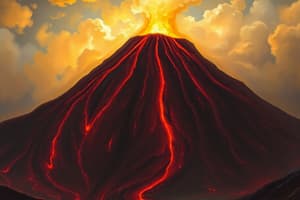Podcast
Questions and Answers
What factors does the formation of magma depend on?
What factors does the formation of magma depend on?
Heat, pressure, and water content.
Volcanoes that form far from plate boundaries form above what are called _____?
Volcanoes that form far from plate boundaries form above what are called _____?
hot spots
What is the long belt of volcanoes that circles the Pacific Ocean called?
What is the long belt of volcanoes that circles the Pacific Ocean called?
The Ring of Fire
What are the primary factors that determine whether a volcano erupts explosively or quietly?
What are the primary factors that determine whether a volcano erupts explosively or quietly?
What is a volcanic vent?
What is a volcanic vent?
Do all volcanic eruptions emit large amounts of gases?
Do all volcanic eruptions emit large amounts of gases?
What are the three main volcanic types?
What are the three main volcanic types?
How is decompression melting of rocks triggered?
How is decompression melting of rocks triggered?
What change allows rock melting to begin at convergent plate boundaries?
What change allows rock melting to begin at convergent plate boundaries?
How many years have most 'hot spots' lasted?
How many years have most 'hot spots' lasted?
What are particles ejected during a volcanic eruption called?
What are particles ejected during a volcanic eruption called?
What is the depression called that forms by the collapse of the top of a volcano?
What is the depression called that forms by the collapse of the top of a volcano?
What is the rock conduit called that remains when the surrounding cone has been eroded?
What is the rock conduit called that remains when the surrounding cone has been eroded?
What is the wide area that forms when low-viscosity basaltic lava flows from fissures?
What is the wide area that forms when low-viscosity basaltic lava flows from fissures?
What are the most dangerous volcanoes?
What are the most dangerous volcanoes?
What three characteristics are used to classify intrusive igneous bodies?
What three characteristics are used to classify intrusive igneous bodies?
What is a sill?
What is a sill?
What is a laccolith?
What is a laccolith?
What is a dike?
What is a dike?
What is a batholith?
What is a batholith?
How is temperature related to viscosity?
How is temperature related to viscosity?
What is the most abundant gas associated with volcanic activity?
What is the most abundant gas associated with volcanic activity?
How do we classify igneous bodies?
How do we classify igneous bodies?
What is pyroclastic flow?
What is pyroclastic flow?
What is pahoehoe flow?
What is pahoehoe flow?
What is aa flow?
What is aa flow?
What are volcanic bombs?
What are volcanic bombs?
What are cinders?
What are cinders?
What is a lahar?
What is a lahar?
What is a volcanic block?
What is a volcanic block?
What are the three types of boundaries associated with volcanism?
What are the three types of boundaries associated with volcanism?
What is a shield volcano?
What is a shield volcano?
What is a cinder cone volcano?
What is a cinder cone volcano?
Flashcards are hidden until you start studying
Study Notes
Magma Formation and Eruption Types
- Formation of magma relies on heat, pressure, and water content.
- Volcanoes distant from plate boundaries emerge over "hot spots" in the crust.
- The characteristics of magma and gas content dictate whether eruptions are explosive or gentle.
- Most volcanic eruptions release significant gas quantities.
Volcano Classification and Evolution
- The three primary volcanic types: shield volcanoes, cinder cones, and composite cones.
- Decompression melting occurs when the pressure on rocks decreases sufficiently.
- Water's presence at convergent boundaries lowers melting points, facilitating rock melting.
Volcanic Structures and Features
- A volcanic vent is an opening to the Earth's surface where eruptions occur.
- Particles emitted during eruptions range from fine dust to large fragments, termed pyroclastic material.
- The depression formed by a volcano's collapse is known as a caldera.
- Erosion of the surrounding cone leaves behind a rock conduit called a volcanic neck.
Lava and Igneous Bodies
- Low-viscosity basaltic lava creates vast lava plateaus when erupted from fissures.
- Composite volcanoes are recognized as the most hazardous volcanic type.
- Intrusive igneous bodies classified by size, shape, and their relation to surrounding rock, include sills, laccoliths, dikes, and batholiths.
Lava Flows and Volcanic Products
- Pahoehoe lava flows are fast, hot, and smooth, forming a wrinkled surface as the underlying lava continues to flow.
- Aa lava flows move slower, cooler, and create a rough surface with sharp projections.
- Pyroclastic flows contain rapidly moving, hot volcanic particles and gases.
- Volcanic bombs are large pyroclastic ejecta exceeding 64 mm in diameter, expelled as glowing lava.
Additional Volcanic Terms
- Cinders are small pyroclastic particles ejected during eruptions, ranging from bead to walnut sizes.
- Lahars are destructive mudflows composed of water-saturated volcanic ash and rocky debris.
- Volcanic blocks are hardened lava fragments larger than 64 mm.
Tectonic Boundaries and Their Impact
- Volcanism occurs at three primary boundary types: convergent, divergent, and intraplate.
- Shield volcanoes feature fluid basaltic lava, creating broad, dome-like structures resembling a warrior's shield.
- Cinder cone volcanoes, with steep slopes, typically result from gas-rich basaltic or rhyolitic magma and can erupt for weeks to years.
Studying That Suits You
Use AI to generate personalized quizzes and flashcards to suit your learning preferences.



